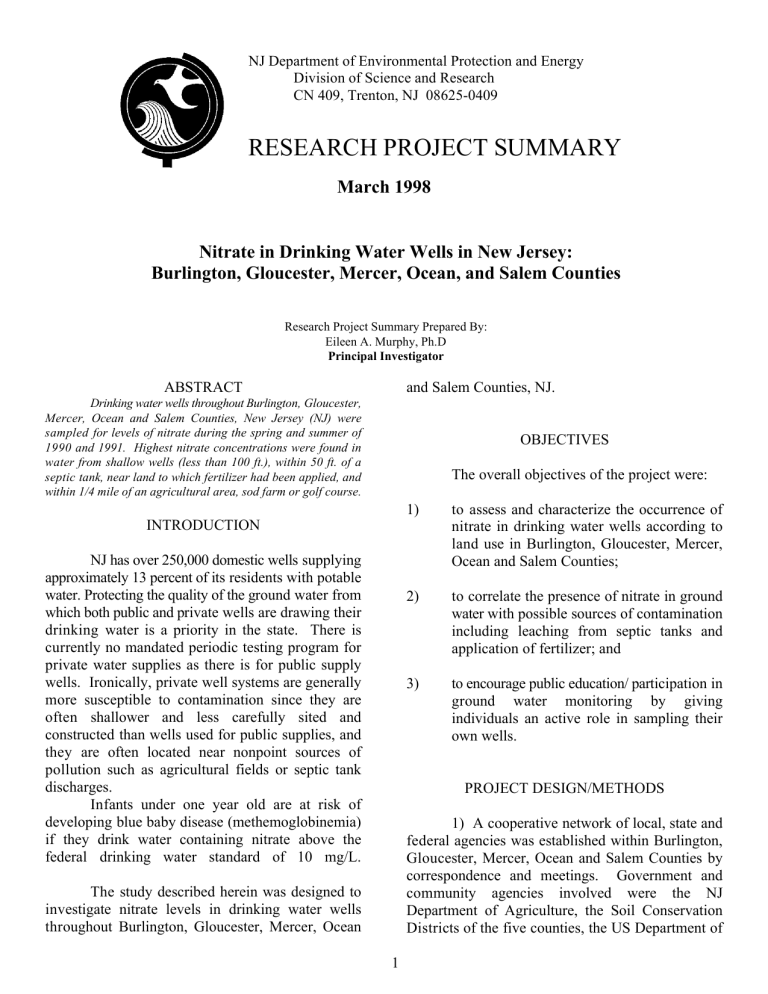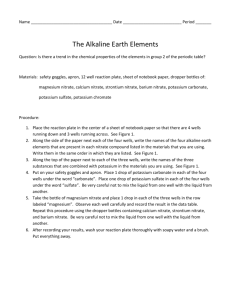NJ Department of Environmental Protection and Energy

NJ Department of Environmental Protection and Energy
Division of Science and Research
CN 409, Trenton, NJ 08625-0409
RESEARCH PROJECT SUMMARY
March 1998
Nitrate in Drinking Water Wells in New Jersey:
Burlington, Gloucester, Mercer, Ocean, and Salem Counties
Research Project Summary Prepared By:
Eileen A. Murphy, Ph.D
Principal Investigator and Salem Counties, NJ. ABSTRACT
Drinking water wells throughout Burlington, Gloucester,
Mercer, Ocean and Salem Counties, New Jersey (NJ) were sampled for levels of nitrate during the spring and summer of
1990 and 1991. Highest nitrate concentrations were found in water from shallow wells (less than 100 ft.), within 50 ft. of a septic tank, near land to which fertilizer had been applied, and within 1/4 mile of an agricultural area, sod farm or golf course.
OBJECTIVES
The overall objectives of the project were:
INTRODUCTION
1) to assess and characterize the occurrence of nitrate in drinking water wells according to land use in Burlington, Gloucester, Mercer,
Ocean and Salem Counties; NJ has over 250,000 domestic wells supplying approximately 13 percent of its residents with potable water. Protecting the quality of the ground water from which both public and private wells are drawing their drinking water is a priority in the state. There is currently no mandated periodic testing program for private water supplies as there is for public supply wells. Ironically, private well systems are generally more susceptible to contamination since they are often shallower and less carefully sited and constructed than wells used for public supplies, and they are often located near nonpoint sources of pollution such as agricultural fields or septic tank discharges.
Infants under one year old are at risk of developing blue baby disease (methemoglobinemia) if they drink water containing nitrate above the federal drinking water standard of 10 mg/L.
The study described herein was designed to investigate nitrate levels in drinking water wells throughout Burlington, Gloucester, Mercer, Ocean
2)
3) to correlate the presence of nitrate in ground water with possible sources of contamination including leaching from septic tanks and application of fertilizer; and to encourage public education/ participation in ground water monitoring by giving individuals an active role in sampling their own wells.
PROJECT DESIGN/METHODS
1) A cooperative network of local, state and federal agencies was established within Burlington,
Gloucester, Mercer, Ocean and Salem Counties by correspondence and meetings. Government and community agencies involved were the NJ
Department of Agriculture, the Soil Conservation
Districts of the five counties, the US Department of
1
Agriculture and the Soil Conservation Services of the five counties, township environmental commissions and county Cooperative Extension Services. Private organizations included the NJ Farm Bureau and other state and local farm representatives. This type of cooperation is imperative in this type of monitoring design, because these groups can advertise and solicit the cooperation of their constituents in a way that cannot be done at the state level. Local agencies, i.e., township environmental commissions, assisted in advertising the program to the general public.
Likewise, county-wide agencies, i.e., Soil
Conservation Districts, promoted the project among the farming communities.
2) A questionnaire was developed by scientists from the agencies listed above for dissemination to participants for information regarding their wells.
3) Sample kit distribution and collection was performed by Division of Science and Research
(DSR) personnel at local government agencies, at special forums in public meeting rooms, and by mail.
When more than one well on a property was available, the owner was encouraged to sample all of them. During the distribution period, staff was available to answer questions and help participants locate their wells and septic tanks on a USGS topographical map of the area. The well and septic tank locations were marked with the key code which appeared on the sample bottles. Questionnaires, sample bottles and well locations were identified by a key code number in order to assure the confidentiality of participants' results.
4) Well owners collected their water samples according to instructions included in the sampling kit.
The instructions were to select a water tap closest to the well head (before the water storage unit if possible), run the water for three minutes, then fill the sample bottles. Pre-paid postage on the kit enabled participants to mail their water samples to the analytical lab. Samples generally were received by the lab within two days of mailing.
5) Water samples were analyzed by
Heidelberg College's Water Quality Laboratories in
Tiffin, Ohio using EPA approved method 353.2. The method detection level for nitrate-nitrogen was 0.01
2 mg/L.
6) Each participant received a computer printout and interpretation of the results of the water quality analyses from the Water Quality Lab. In cases where nitrate levels were high, a suggestion for repeat sampling was made.
7) A total of 105 quality assurance/control samples were analyzed for this project. These samples consisted of duplicate analyses, blanks and blind spikes. Thirty-nine of the 792 wells sampled were sampled twice. Blind spikes and blank samples were sent to the lab for analysis on seven occasions.
All water samples were analyzed on the day they were delivered to the lab. Since the analytical methods for this project were automated, the lab was able to handle the volume of samples generated per day. QA/QC results indicated that no nitrate was lost from samples during the mailing process. Therefore, although samples were not iced when mailed to the analytical lab, no loss of nitrate in the water sample occurred in the mail.
In five cases, water samples were collected from the same well but from different taps in the household - at the kitchen tap (after a water treatment unit) and at the tap before the water storage tank. In all five instances, the nitrate level from water coming out of the kitchen tap was not different from that from the other tap.
RESULTS & DISCUSSION
Of the variables studied in this project, the greatest correlations with nitrate contamination of a well were well depth (shallow wells were more vulnerable to contamination than deeper wells) and the presence of a nitrogen source (i.e., septic tank and/or application of fertilizer). Summary results for all wells are presented in Table 1. Figure 1 shows the locations of wells sampled and their corresponding nitrate concentrations.
In Table 2, nitrate levels according to the predominant land use within 1/4 mile of the well are presented. Concentrations in water from wells near agricultural and sod/golf areas were significantly higher than concentrations elsewhere. This is due probably to the application of fertilizers in these areas.
Results of a multiple regression using land use, proximity to a septic tank and application of fertilizer as the independent variables and nitrate as the dependent variable for wells less than 100 ft.
Nonparametric correlations using each individual independent variable with nitrate as the dependent variable resulted in nonsignificant relationships. The combined influence of all three independent variables was more influential on nitrate levels in shallow wells than any single independent variable.
CONCLUSIONS
Of the 792 wells samples as part of this study,
47 (or 6%) contained nitrate levels exceeding the federal drinking water standard of 10 mg/L. In contrast, 516 (65%) of the wells sampled contained nitrate levels below 2.0 mg/L, the level at which nitrate is considered to be naturally occurring.
It is apparent from this research and from the work of others reported in the literature that the following factors should be considered when attempting to predict the vulnerability of a well to nitrate contamination in NJ: 1) depth of the well; 2) proximity of the well to a septic tank; 3) application of fertilizer nearby; and 4) land use within 1/4 mile of the well.
FUNDING SOURCE
This work was funded by the A-280 Safe
Drinking Water Research Program.
Eileen Murphy is a Research Scientist in DSR working on research projects involving contamination of drinking water by inorganic chemicals. DSR
Reference No: 94___.
3
Table 1. Median Nitrate-Nitrogen Values for All
Wells Sampled in Burlington, Gloucester, Mercer,
Ocean and Salem Counties, NJ
Parameter # Wells
Ranges
(mg/L)
Median
(mg/L)
WELL DEPTH
< 15 meters
16-30 meters
$ 30 meters
DISTANCE TO
SEPTIC
0-15 meters
16-38 meters
> 38 meters
NO SEPTIC
FERTILIZER
NONE
MANURE
CHEMICAL
BOTH
242
277
273
301
42
410
23
94
388
108
201
BD*-22.8
BD-23.3
BD-14.55
BD-22.2
BD-22.8
BD-23.3
BD-17.56
BD-22.1
BD-11.69
BD-23.3
BD-13.97
2.98a**
1.09b
0.10c
2.01a
0.39b
0.20b
0.30b
0.23a
1.89b
0.60b
2.51b
Table 2. Median Nitrate-Nitrogen Values for Wells
Less Than 100 ft. Sampled in Burlington, Gloucester,
Mercer, Ocean and Salem Counties, NJ.
Predominant Land
Use
# of
Wells Range
(mg/L)
Median
(mg/L)
3.91a
AGRICULTURE
SOD/GOLF
75
6
BD-23.3
4.36-14.5
7.32a
1.40b
PASTURE
RESIDENTIAL
32
319
BD-13.87
BD-22.8
1.40b
*
**
WOODLAND 30
BD = Below Detection
BD-9.1
1.00b
Medians with the same letter within a heading represent populations which are not significantly different at the 0.05
level as determined by the Mann-Whitney Two Sample Non-
Matched Test for Nonparametric Distributions.
4








